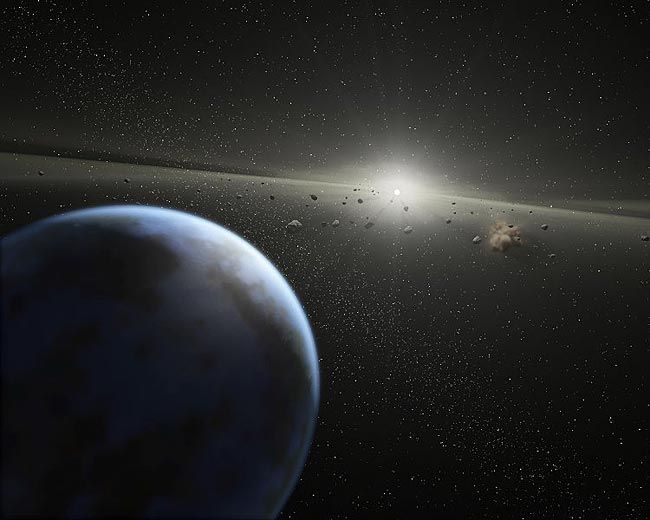Catastrophic Impacts Made Life Flourish

Space rocks are blamed for a lot of rough times on Earth, from the die-off of most marine animals some 250 million years ago to the disappearance of the dinosaurs 65 million years in the past.
A new theory, however, suggests that catastrophic meteorite impacts are linked to an explosion in biodiversity about 470 million years ago, during the Ordovician Period. Within a few million years, the number of trilobite species and scores of other creatures on Earth jumped at least three to four times.
Birger Schmitz, a geologist at the University of Lund in Sweden who worked for more than 10 years to help gather evidence backing up the claim, is the first to admit that his group's findings are hard to swallow.
"It seems completely at odds with anyone's expectations," Schmitz said, "but you have to remember, for example, that it was at first difficult for many scientists to accept asteroid explanations for the disappearance of the dinosaurs."
Schmitz and his colleagues detail their findings in the Dec. 16 advance issue of the journal Nature Geoscience.
Smackdown
Just before the jolt to Ordovician life, Schmitz said two massive bodies in the Asteroid Belt slammed into one another, littering the solar system with rocks the size of Manhattan island and ranging down to microscopic bits of dust.
Sign up for the Live Science daily newsletter now
Get the world’s most fascinating discoveries delivered straight to your inbox.
"Even today, more than 20 percent of the meteorites we see came from this breakup event," Schmitz said. That makes the L-chondrite meteorites, as they're known, the most common kind to rain down on Earth.
Such extraterrestrial rocks contain a unique form of radioactive chromium, so Schmitz and his team were able to figure out precisely when, how much and how often the cosmic debris slammed into Earth.
"We saw a sudden jump in meteorite material around the time of increased biodiversity," Schmitz said — greater than 100 times more material, in fact. "That's a major event, and an incredible coincidence that I don't think we should ignore," he told LiveScience.com.
Schmitz cautioned that while the two events line up in an uncanny way, there is still a lot of work left to do to connect the increased meteorite impacts to inflating biodiversity.
"It took us about 15 years to accumulate data for this finding, and it's something that isn't just a computer model or simulation. It's real, tactile evidence," he said of the work, which included slowly acid-dissolving almost a ton of rock collected from around the world to sift out bits of chromium.
The scientists compared their meteorite record to layers of fossilized plants and animals, determining that the cosmic smashup happened shortly before the biodiversity boost.
"I expect that it will take us another 15 years of playing in the dirt to get there, to find Ordovician impact craters and beds associated with this breakup," he said.
Pushing their luck
Schmitz isn't certain exactly how pummeling the planet with rocks could cause life to thrive, but he thinks it has something to do with creating new nooks and crannies for life to adapt to in its new environment.
"Before the breakup you had primitive animals adapted to rough conditions, so you could say they were prepared for the storm," Schmitz said.
Schmitz also explained that evolution is very much "give-and-take," as radiating into new species requires a figurative kick in the shins.
"If you push an ecosystem too hard, you'll destroy it," he said. "But for the organisms living on Earth at the time, [the environment] pushed them to adapt and fill new niches. It's like at the university: I tell my students all the time that if we don't push you, you don't evolve."
Whether or not the cosmic smashup ultimately caused life on Earth to thrive 470 million years ago, the connection between events in space and life on Earth is intriguing, Schmitz said.
"There's much more to be learned how the history of Earth and its life is related to the universe," he said. "We're only in the beginning of exploring that connection."
- Top 10 Ways to Destroy Earth
- Video: The Asteroid Paradox
- The Wildest Weather in the Galaxy












